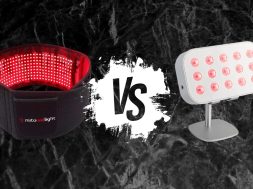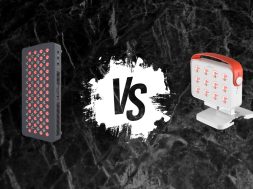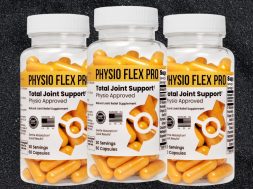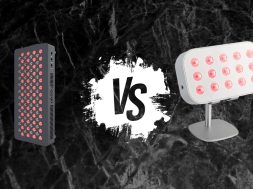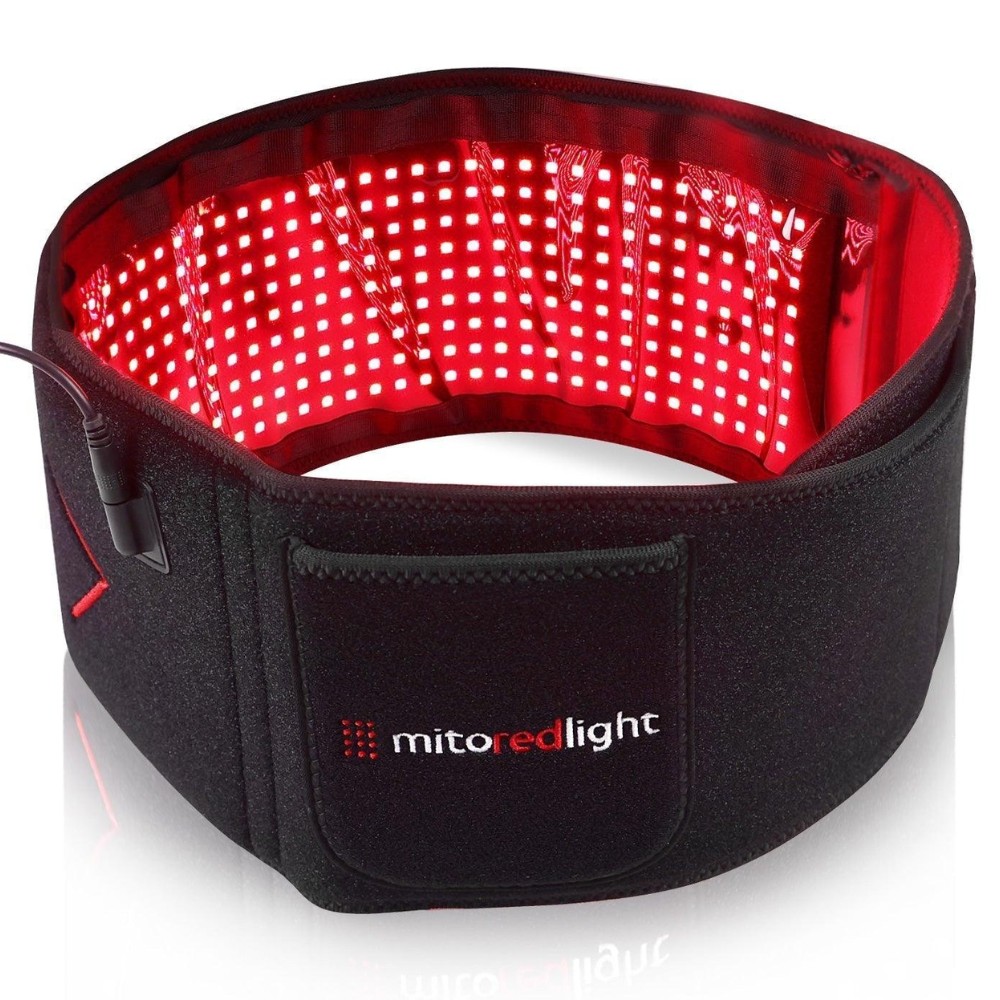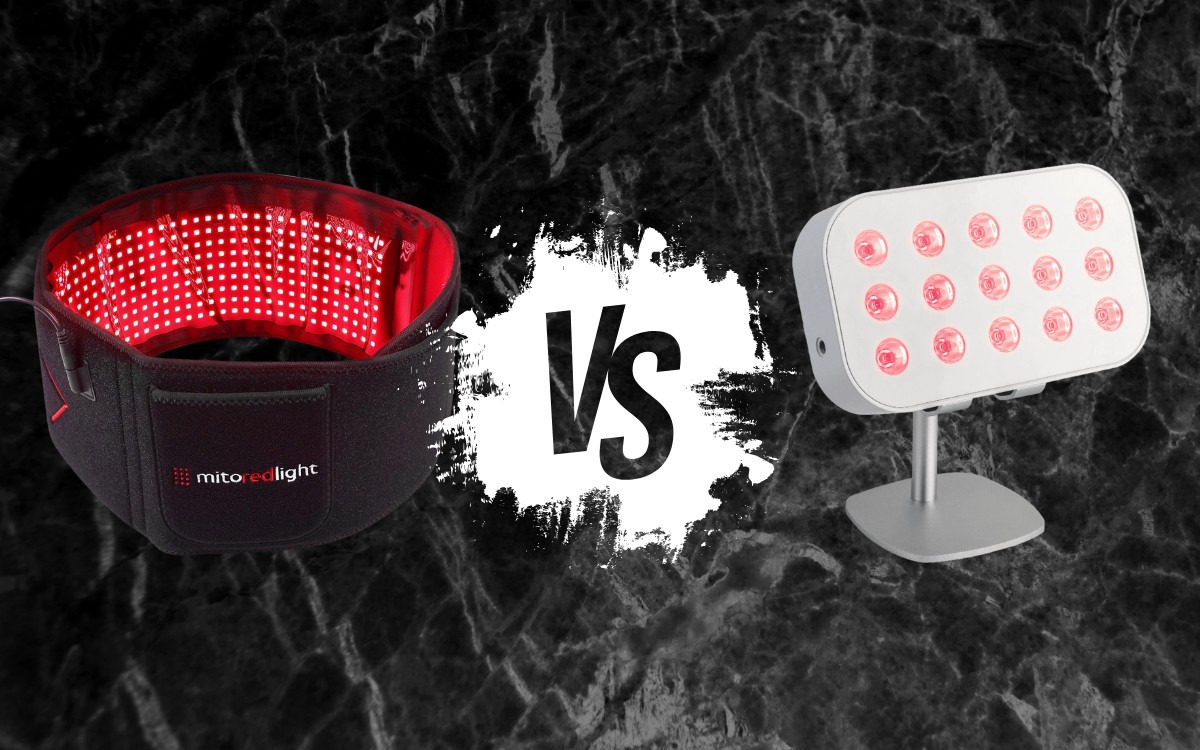
Red light therapy has moved from the fringes of wellness clinics into home recovery setups everywhere, and for good reason. Whether you’re lifting heavy, training on the mats, or just trying to bounce back faster from daily stress, the science behind photobiomodulation is compelling. Specific wavelengths of red and near-infrared light can boost mitochondrial function, reduce inflammation, and speed up tissue repair.
But not all devices deliver the same experience. Some are built for convenience, others for sheer output. Two of the most popular mid-range options right now, the MitoQUAD Wavelength Belt and the Lumebox 2.0, represent two very different design philosophies.
I’ve tested both devices extensively over several weeks, integrating them into my training schedule that includes weightlifting, grappling, and chasing after two kids. Here’s what I found and which one actually deserves a spot in your recovery arsenal.
| Feature | Winner |
|---|---|
| Performance & Effectiveness | Draw |
| Wavelengths | Mito |
| Design & Build Quality | Draw |
| Ease of Use | Mito |
| Battery | Draw |
| User Reviews | Mito |
| Price | Mito |
Quick Verdict
Both devices perform well, but if I had to choose one for real-world athletic recovery, the MitoQUAD Wavelength Belt wins.
It offers four clinically supported wavelengths (630nm, 660nm, 810nm, and 850nm) that target both surface and deep tissue recovery, plus a flexible, hands-free design that fits into daily life which is something the Lumebox simply can’t match.
The Lumebox 2.0 delivers strong irradiance and premium build quality, but its stationary, corded setup limits its practicality for anyone with an active schedule.
It’s great for skin health and general soreness, yet the MitoQUAD provides more coverage, more versatility, and better value at almost half the price.
What Is Mito Red Light?
The MitoQUAD Wavelength Belt is a wearable red light therapy device made by Mito Red Light, designed to bring clinical-grade photobiomodulation into a portable, easy-to-use format. Instead of standing in front of a bulky light panel, you can strap this belt around your waist or lower back and go about your day, making it one of the most practical devices in this category.
It uses TriChip LED technology, meaning each of its 405 diodes contains three light chips for a total of 1,215 LEDs across the belt. These cover four key wavelengths:
- 630nm and 660nm (Red Light) – for skin, circulation, and cellular energy
- 810nm and 850nm (Near-Infrared) – for deeper tissue penetration, muscle recovery, and inflammation reduction
This quad-wavelength mix is designed to stimulate recovery at multiple depths simultaneously, which gives it an edge over most dual-wavelength competitors. The belt meets IEC 60601 medical device safety standards, ensuring both build quality and consistent light output.
At about 1.2 pounds and roughly 48 inches long, it fits most users comfortably (waist sizes 28–44″).
The interface is minimal: five brightness levels, a simple power button, and LED indicators. You can start a 15–20-minute session in seconds, then move freely (you’re still limited by the power chord though).
For athletes or anyone dealing with recurring back stiffness, hip tightness, or inflammation, the MitoQUAD feels less like a gadget and more like a practical recovery tool you’ll actually use daily.
Pros
- Quad-wavelength coverage (630, 660, 810, 850nm) targets both skin and deep tissue recovery
- Hands-free wearable design — perfect for multitasking
- High LED density (1,215 chips) for even light distribution
- IEC 60601 certified for medical-grade safety and consistency
- Noticeable reduction in stiffness and soreness with regular use
- Intuitive controls and multiple intensity levels
Cons
- Corded (no battery option) limits true portability
- Fixed width means it’s great for back and core, but harder to position on smaller joints
- Slightly heavy compared to simpler wrap devices
- No app or session tracking (purely manual operation)
What Is LumeBox?
The Lumebox 2.0 sits at the other end of the red light therapy spectrum — literally and figuratively. Instead of a wearable wrap, it’s a handheld panel-style device built for those who want a powerful, clinic-grade experience at home.
Lumebox combines 660nm red light and 850nm near-infrared light, the two most research-backed wavelengths for photobiomodulation.
Red light primarily targets skin-level improvements like circulation, collagen production, and cellular energy, while near-infrared penetrates deeper to influence muscles, joints, and connective tissue.
What makes the Lumebox stand out is its output power. With an irradiance of 125 mW/cm² for red light and 140 mW/cm² for near-infrared, this thing packs serious energy.
Those are elite numbers for a home-use device and explain why many users compare it favorably to much larger panels that cost twice as much.
The device itself feels premium the moment you unbox it. The outer shell is solid and ergonomic, not cheap plastic, with a well-balanced handle that allows precise positioning.
The new 2.0 version improved on the previous model’s comfort and cooling and it now stays cool even during back-to-back 12-minute sessions.
Ease of use is another highlight. There’s no app, no Bluetooth, no pairing, just plug it in, choose between 6- and 12-minute timer presets, and start your session. The beeping indicator tells you when time’s up, which is surprisingly convenient.
Its portable-but-corded design means you can move it between home, gym, or office easily, but you’ll still need access to a wall outlet during use. The included padded carrying case adds a nice professional touch and keeps everything protected during travel.
Performance-wise, the Lumebox delivers visible and measurable effects when used consistently. It reduces post-training soreness, helps with minor joint stiffness, and even improves skin tone over time.
But while its light output is elite, the form factor limits flexibility. You have to hold it in place or prop it up, which isn’t ideal for long or multi-area sessions. You can read my Lumebox review for my experience.
Pros
- High irradiance (125–140 mW/cm²) for strong, effective light delivery
- Dual 660nm + 850nm wavelengths cover both surface and deeper tissue recovery
- Excellent build quality with ergonomic handle and durable casing
- Simple interface — no app or setup required
- Noticeable improvements in soreness, stiffness, and skin quality
- Includes a protective, padded travel case
Cons
- Corded — no battery or wireless option
- Not hands-free — requires manual positioning or setup stand
- Limited treatment coverage area
- Premium price ($629) compared to similar-performance devices
- No adjustable intensity or wavelength settings
Mito Red Light vs. LumeBox Main Differences
Performance and Effectiveness
Both devices deliver legitimate therapeutic benefits like reduced soreness, faster recovery, and general improvements in tissue comfort. But they achieve those results in very different ways.
The MitoQUAD focuses on coverage and consistency. With 1,215 LED chips and four wavelengths, it spreads energy evenly across the entire treatment zone.
That makes it excellent for larger muscle groups like the lower back, hips, or abs. During testing, I found the MitoQUAD particularly effective after heavy squats or grappling sessions as it reduced morning stiffness and helped with general recovery between sessions.
The Lumebox, on the other hand, delivers more raw power per square inch. Its irradiance levels (125–140 mW/cm²) hit harder, making it better suited for smaller, specific areas like shoulders or knees.
However, that power is limited by its treatment area, and you need to manually hold or reposition it for each spot.
If you’re after a high-performance recovery tool that integrates easily into daily life, the MitoQUAD wins. The Lumebox shines for precision and potency, but the need to stay stationary makes it less realistic for consistent use.
Wavelengths
This is where the difference is stark.
The MitoQUAD uses four distinct wavelengths — 630nm, 660nm, 810nm, and 850nm. That combination covers both red and near-infrared spectrums, addressing surface-level cellular energy (red) and deeper muscular or joint recovery (NIR). The 810nm and 850nm wavelengths penetrate several centimeters into tissue, reaching muscle fibers and even joint capsules.
The Lumebox 2.0 sticks with the classic dual setup of 660nm red and 850nm near-infrared. That’s a proven and effective mix, but it lacks the spectrum diversity of the MitoQUAD.
The two extra wavelengths in the MitoQUAD allow it to stimulate a wider range of cellular responses, making it more versatile for recovery, inflammation control, and even skin health.
It’s like comparing a single-purpose strength tool to a multi-grip barbell — both get the job done, but one gives you more angles to work with.
Design and Build Quality
Both devices feel premium, but their designs serve different purposes.
The MitoQUAD is built like a professional-grade wearable: flexible silicone, integrated control panel, and an adjustable strap that secures comfortably around the waist or lower back.
Despite its dense LED array, it stays relatively cool and distributes light evenly. It’s not lightweight, but the structure feels solid and medical-grade.
The Lumebox feels more like a handheld instrument. It’s compact, balanced, and engineered with quality materials and you can tell it’s made to last.
The new handle design in the 2.0 version improves grip and comfort, and the cooling system keeps temperatures low even after long sessions.
The key tradeoff is mobility vs. precision.
- The MitoQUAD is hands-free, covers more area, and fits naturally into movement or multitasking.
- Lumebox has better precision targeting, but requires manual control.
If you want something that integrates seamlessly into your recovery routine without needing your constant attention, the MitoQUAD’s design is simply more practical.
Ease of Use
This one’s not even close.
The MitoQUAD is plug, wrap, and go. You set the intensity (five levels available), strap it around the treatment area, and get on with your day — work at your desk, stretch, or relax on the couch. It’s truly “set it and forget it.”
The Lumebox is also easy to operate with no app or account setup, but it’s not hands-free. You have to position it manually or rest it on a stand, stay within a specific distance from your skin, and monitor the 6- or 12-minute session. It’s great for short treatments but less convenient for long, repetitive use.
If you value consistency, which is actually the biggest factor in red light therapy results, the MitoQUAD makes it easier to stick with your routine.
Battery Life and Hardware
Neither device is truly wireless, which is a limitation in 2025. Both rely on AC power, meaning you’ll need a nearby outlet. That said, their internal engineering and heat management differ significantly.
The MitoQUAD uses high-density TriChip LEDs with even output across the full belt. Despite its power, it manages heat efficiently and never overheats.
The integrated control module feels robust, though the lack of a detachable controller or battery pack means you’re always tethered to the cord.
The Lumebox benefits from continuous, consistent power since it’s corded. Its LED array is extremely stable, showing no dimming over time.
The cooling fan system is excellent, and build quality is professional. However, it’s also the reason it’s less portable — it’s built like a tank, and you feel that weight during use.
In day-to-day reality, hardware quality is comparable, but the MitoQUAD’s flexibility and wearable format make it far more usable in the real world.
Price
Here’s where things get very clear.
| Device | Price (USD) | Power Type | Coverage Area | Wavelengths | Warranty |
| MitoQUAD Wavelength Belt | $350 | Corded | Core, lower back | 630, 660, 810, 850nm | 1 year |
| Lumebox 2.0 | $629 | Corded | Small–medium localized area | 660, 850nm | 1 year |
At almost half the price, the MitoQUAD offers broader wavelength coverage, hands-free use, and higher LED density, making it the better value for athletes and active individuals. The Lumebox justifies its cost through higher irradiance and premium materials, but its limited versatility makes it a tougher sell unless you specifically want a handheld, stationary device.
My Experience Using Mito Red Light & LumeBox
I’ve used both the MitoQUAD and Lumebox 2.0 for several weeks, testing them through the full spectrum of what my training throws at me: heavy snatches and clean and jerks, grappling sessions, and the kind of day-to-day wear that comes from balancing work, parenting, and my own workouts.
MitoQUAD Wavelength Belt
I started with the MitoQUAD, using it mainly on my lower back and hips four to five times a week. That area takes the most beating between lifting and rolling, so it was the perfect test zone.
The first thing that won me was the convenience. Once you strap it on, you forget it’s there. I’d write video scripts, review footage, or prep meals while the light session ran its course.
That hands-free design meant I was actually consistent, which is something I’ve struggled with when using rigid panel-style devices that require you to stand still.
By week two, I noticed subtle but real differences. Morning stiffness after leg day wasn’t as pronounced, and that heavy, compressed feeling in the lower back eased up faster. I also found that my overall recovery between sessions improved. Not dramatically, but enough to make a difference when training frequency is high.
The warmth feels therapeutic without being hot, and the light distribution is smooth. I ran most sessions at intensity level 3 for around 18 minutes, which seemed to be the sweet spot.
One thing to note: it’s not ideal for everything. When I tweaked my shoulder during grappling, the fixed belt design couldn’t target that area effectively.
I tried wrapping it diagonally across the upper back, but it wasn’t comfortable or stable enough to hold. The MitoQUAD really shines when used for the core, lower back, or hip region, but it’s not built for precision targeting.
Still, in terms of usability and consistency, this device made recovery feel less like a chore and more like part of my normal routine.
Lumebox 2.0
The Lumebox, in contrast, felt more like using a professional recovery tool — powerful, focused, and well-engineered, but also more demanding.
From the first session, you can tell this thing packs serious irradiance. Holding it six to eight inches from the skin, you feel that deep warmth kick in quickly, especially on sore quads or knees.
After tough lower-body sessions, I’d run 12-minute treatments per leg, alternating sides. The soreness the next day was noticeably reduced, especially when compared to untreated sessions.
I also tested it for shoulder stiffness after pressing days. The results were decent, but it required sitting still and holding the device in the same position for 10 minutes straight.
The build quality is excellent, and the light stays cool even during long sessions. I liked the timer presets (6 and 12 minutes), which made it brainless to operate.
But after a few weeks, I realized that even though the Lumebox delivered good results, I was using it less often simply because of the hassle factor.
When you have to carve out time, plug in, sit still, and hold it over each muscle, it becomes another task. In contrast, the MitoQUAD became background recovery and part of daily life.
Where the Lumebox did impress me was skin quality and general tissue comfort. I used it on my face a few times before bed and noticed slight improvements in skin texture and even sleep quality. So while it’s not my go-to recovery tool, it has value for relaxation and superficial treatment.
Should You Choose Mito Red Light or LumeBox
Both of these devices deliver legitimate red light therapy benefits. They’re not gimmicks, and they’re not the cheap, underpowered knockoffs flooding the market.
The difference comes down to how you’ll actually use them, because consistency and practicality matter far more than peak numbers on a spec sheet.
If you’re a busy professional, parent, or athlete who already struggles to fit recovery into your week, the MitoQUAD Wavelength Belt is the better long-term choice.
Its hands-free design means you’ll actually use it consistently, and the quad-wavelength array gives you both surface-level and deep-tissue stimulation in one go. It’s powerful enough to support recovery from training, yet easy enough to run daily without thought.
The Lumebox 2.0, on the other hand, is for users who prioritize power and precision over convenience. If you don’t mind staying still for 10–12 minutes per area, and you want to focus on specific joints or skin treatments, it’s an excellent device. The irradiance is elite, the cooling is well-engineered, and it feels built to last.
But for most people, especially non-professional athletes and active individuals, the Lumebox will eventually end up sitting on a shelf, not because it’s bad, but because it’s too stationary. And recovery tools that require discipline to use are rarely used as often as they should be.
In short, I would recommend MitoQUAD if you want a practical, everyday recovery device that supports your training lifestyle.
If you want a stationary, high-power light for specific pain spots or skin treatments, the Lumebox delivers.
MitoQUAD Wavelength Belt
MitoQUAD Wavelength Belt
Powerful red light therapy device designed be applied without having to sit in front of a large light panel.
CHECK CURRENT DEALS